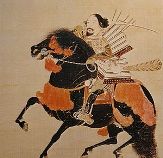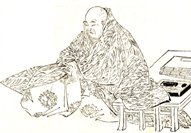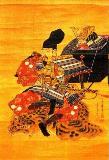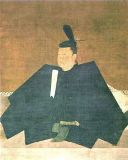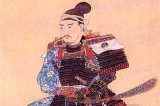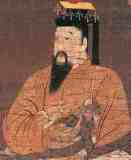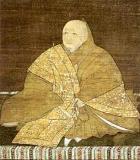
|
Table of Contents
Muromachi Era 室町時代 1336-1500 Resources
Primary Materials 加能史料編纂・Kano (Kaga Noto) Collection of Historical Resources Volume One
|
Source: Ishii Susumu, Kasahara Kazuo, Kodama Yukita, Sasayama Haruo "Shosetsu Nihonshi Kaiteiban" (詳説日本史改訂版), Yamakawa Publishing, Tokyo, 2002, pp.115-126 From the mid Kamakura period, the Imperial family was divided into the Jimyōin line(持明院統) (descended from Emperor Gofuku-kusa)and the Daigakuji (大覚寺) line (descended from Emperor Kameyama), who subsequently began to argue over powers associated with succession and retirement, along with rights to imperial estates. This led both lines to attempt to exercise their influence on the Kamakura Bakufu (1190-1333) in order to gain an advantage over their imperial rival. To resolve this situation, the Kamakura Bakufu set in place a system that rotated the position of emperor between both lines (a system known as the Ryōtō Tetsuritsu – 両統迭立), the arrangements of which led to a weakening of the imperial court`s power by splitting its authority.(115)
It was in the midst of this situation that Emperor Godai-go (後醍醐天皇) succeeded to head the Daigakuji line. An avid student, Godai-go devoted himself to reading works brought from Yuan China on the various means of justifying one`s actions, which in turn convinced him of the need for government reform. He would in turn pursue his idea for a restoration of imperial authority by abolishing the system of Insei (院政), or power exercised by proxy (i.e, via the Bakufu). At the time, the Uchi Kanrei (内管領) Nagasaki Takasuke (長崎高資), under the auspices of the Shikken (執権) Hōjō Takatoki (北条高時), exercised power as he saw fit. This degree of self-interest combined with political authority gradually raised the ire of the Gokenin (御家人) families located in the eastern provinces, while in the central provinces the activities of akutō (悪党) had increased, causing havoc in both town and countryside alike. (115) This news spurred Godai-go to plot to overthrow the Kamakura Bakufu, however in 1324 (the first year of Shōchū) the content of the plot was leaked to the Bakufu, and thus ended in failure (the incident itself was known as the Shōchū Rebellion, 正中の変). Nevertheless, Godai-go did not renounce his intention to overthrow the Bakufu, and in 1331 (the first year of Genkō) raised troops with the intention of using them against the Bakufu representative in Kyoto, the office at Rokuhara. This revolt too ended in failure (and is known as the Genkō Rebellion, 元弘の変). The Bakufu subsequently installed Emperor Kōgon (光厳天皇) of the Jimyōin line to the imperial throne, and in the following year banished Godai-go into exile on the island of Oki (隠岐) in the far west.(115) Meanwhile Godai-go`s son, Emperor Moriyoshi (護良親王-1308-1335), together with Kusunoki Masashige (楠木正成 – 1294-1336), utilising the dissatisfaction of many recently appointed warrior households towards the Kamakura Bakufu, rose in revolt against the Hōjō, which led to the outbreak of fierce fighting against the Bakufunate`s allies and troops. While this was continuing Godai-go managed to escape from Oki, and by appealing to warriors in the west to join him in overthrowing the power of the Kamakura Bakufu, steadily increased the number of supporters at his side. It was at this time that a particularly influential member of the Gokenin families of the east was dispatched by the Kamakura Bakufu to quell the uprising in the west. The name of this individual was Ashikaga Takauji (足利高氏, later to be renamed as 尊氏 – 1305-1358).(116) Upon arriving in the west, Takauji examined the situation before him. Convinced that further obedience to the Hōjō was no longer warranted, he turned against his former employer and attacked the Rokuhara Tandai, destroying it and forcing its remaining members to flee. Meanwhile in the east, Nitta Yoshisada (新田義貞 – 1301-1338) attacked and destroyed the Hōjō residence at Kamakura, wiping out both Hōjō Takatoki and his entire entourage. By 1333 (Genkō 3), the Kamakura Bakufu was no more.(116) The Kenmu Restoration Emperor Godai-go gradually made his way back to the capital at Kyoto and began a new era of rule. In the year following Genkō 3, Godai-go had the yearly appellation changed from Genkō to Kenmu (建武), and thereafter the rule of Godai-go was referred to as `the Kenmu Restoration`. This form of government sought to do away with the institutions of the Bakufu and Insei, along with the court positions of Sessei (摂政) and Kanpaku (関白). It would be a government centred exclusively on the figure of Godai-go, a physical manifestation of his idea of imperial rule. However Godai-go soon learned that he could not completely forego the changes wrought by the Kamakura Bakufu, and so installed an `office of records` (otherwise known as the Kirokusho, or 記録所) as the highest administrative institution in his new form of government, along with the Zasso Ketsudansho (雑訴決断所, a type of military court) as a successor to the institution of the Bakufu. In the provinces he appointed both Kokushi (国司) and Shugo (守護). In order to control the far north and eastern provinces, he created the positions of Mutsu Shōgunfu (陸奥将軍府) and Kantō Shōgunfu (関東将軍府), and installed imperial princes to these roles. In truth, these two institutions bore more than a passing resemblance to the former Bakufu structure, and became heavily reliant on the use of warriors.(116) At the beginning of the Kenmu reign Godai-go sent out a decree (known as a Rinji, 綸旨) which stated that all lands and the titles to them would require his approval before being confirmed. As this practice completely ignored the laws and customs of the warrior-based society that preceded it, it provoked the warrior classes into rebellion. When coupled with the complex nature of the government`s administrative organs and the acrimonious human relations within it, very soon Godai-go`s government became paralysed by infighting, which in turn led to outbreaks of civil strife.(117) Examining the situation that now lay before him and the dysfunctional nature of Godai-go`s rule, in 1335 (Kenmu 2) Ashikaga Takauji used a rebellion by the son of Hōjō Takatoki, Tokiyuki (known as the Nakasendai Rebellion, or 中先代の乱), as a reason for him to return to the east in order to quell the rebellion and end Tokiyuki`s control of Kamakura. When he reached the Kantō region, Takauji unfurled his own banner of rebellion against the rule of Godai-go.(117) The chaos of the Nanbokuchō era After taking control of Kyoto in 1336 (Kenmu 3), Ashikaga Takauji installed Emperor Kōmyō (光明天皇 – 1336-1348) of the Jimyōin line. In order to make clear his intention to create a Bakufu government of his own, Takauji introduced the laws that would govern in it by releasing the Kenmu Shikimoku (建武式目). This new form of government spelt the end of the rule of the Kenmu reign less than three years after it had been formed. Emperor Godai-go fled the capital and headed for the mountains at Yoshino (吉野, part of modern Nara prefecture). From there he continued to insist that he was the legitimate imperial ruler. The court at Yoshino thus became known as the Southern Court (or Nanchō, 南朝), while the Jimyōin line in Kyoto became known as the Northern Court (or Hokuchō, 北朝). This rivalry between the two courts was to lead to almost 60 years of nationwide conflict (known as the Nanbokuchō wars, or 南北朝の動乱). (117) For the Southern Court, the deaths of both Kusunoki Masashige and Niita Yoshisada early in the conflict were indeed tragic, however in their wake resistance to the Ashikaga was led by Kitabatake Chikafusa (北畠親房), who soon ensured that rebellion against the Ashikaga spread to the Tōhoku, Kantō, and Kyūshū regions. Meanwhile, in 1338 (the first year of Ryakuōu, 暦応) the Northern Court appointed Takauji to the position of Seii Tai Shōgun (征夷大将軍), while government itself and the duties within it were divided up between himself and his younger brother, Tadayoshi (直義 – 1306-1352). (117) However problems soon emerged between the supporters of a steady progression of powers advocated by Naoyoshi, and those who wanted a rapid expansion in power, who soon rallied around the figure of Kōno Moronao (高師直 – unknown – 1351), Takauji`s chief strategist (or Shitsuji, 執事). In 1350 (the first year of Kannō 観応) armed conflict broke out between both sides, the effects of which led to incidents of rebellion in various parts of the country (a period known as the disturbances of Kannō, or 観応の擾乱). Even after the death of Naoyoshi the conflict continued, leading to the bizarre situation in which the forces of Takauji, those belonging to the former Naoyoshi faction, and those belonging to the Southern Court formed and broke alliances with one another over a ten year period.(118) In the midst of these disturbances, major changes were occurring within society. While the laws and regulations of warrior society continued, gradually society itself became divided into independent warrior houses and those aligned with more powerful institutions (known as the Tandoku Sōzoku system, or 単独相続). It in turn led to the beginning of the breakdown in the Sōryō (or estate) system. The relationship between the main branch and affiliated branches of warrior families, which had previously belonged to the same entity, began to grow more independent of one another. At a more local level, while the eldest son of a warrior family inherited all of the lands belonging to his family, his siblings, instead of forming their own branch of the family, now acted in support of their elder brother. These changes led to divisions and conflict within warrior families. At the same time, those families aligned with the Southern Court continued to spread rebellion across the country. The changes in turn led groups of rural samurai, who were previously joined by blood relations, to emphasize regional ties instead. Villages in the provinces also began to form themselves into organized collectives in order to resist warrior rule.(118) The chaos of the Nanbokuchō period was progressively lessened by the succession to the Shōgunate of Takauji`s grandson, Ashikaga Yoshimitsu (足利義満), who was finally able to stabilize the rule of the Ashikaga. In 1392 (or the 3rd year of Meitoku 明徳), negotiations with the Southern Court led to a merger between the Southern and Northern Courts, thus bringing the warfare that had plagued government to an end. Not only this, Yoshimitsu also brought the administrative powers of the city of Kyoto, itself the centre of commercial activity in the nation, under the Shōgunate while also establishing the right of the Shōgun to collect taxes from the provinces. He managed all this while also helping to preserve those powers still possessed by the Imperial court. Yoshimitsu thus successfully established a unified, nation-wide authority under the name of the Shōgunate,(118-119) In 1378 (the 4th year of Eiwa, or 永和) Yoshimitsu had a grant residence built in the district of Kyoto known as Muromachi (the building itself was known as the Hana no Gosho, or 花の御所) from which he could exercise his authority. This was the origin of what became known as the Muromachi Bakufu (or Shōgunate). Yoshimitsu was the first Shōgun to be promoted to the position of Dasei Daijin (太政大臣), itself an imperial post, and after taking the tonsure and becoming a priest was able to wield considerable power between both the Shōgunate and Court alike.(119) The administrative apparatus of the Ashikaga Bakufu also underwent changes during this period. The position of Kanrei (管領), which was essentially that of an advisor to the Shōgun, became central within the Muromachi government. At the same time, the posts of Samurai-dokoro and Mandokoro (侍所・政所) became the focal point of bureaucracy, dispatching the orders of the Shōgun to Shugo (守護, or regional governors) living in the provinces. The office of Kanrei was meanwhile shared between three prominent Shugo houses, the Hosokawa (細川), the Shiba (斯波), and the Hatakeyama (畠山), an arrangement that became known as the Sankanrei (三管領). The post of Chōkan (長官, also known as Shoshi, or 所司) which oversaw the Samurai-dokoro, which itself was responsible for the security of the capital and for prosecuting legal cases, was alternatively held by one of four different families – the Akamatsu (赤松), the Isshiki (一色), the Yamana (山名), and the Kyōgoku (京極). This arrangement too was bestowed with its own name, that of Shishiki (四職), or four posts.(119) These prominent Shugo households came to dominate the government centred within Kyoto, establishing themselves in their posts and administering the functions of the Bakufunate. Meanwhile in the provinces, those more regular Shugo families appointed representatives to act in their stead (known as Shugodai, or 守護代) while the Shugo themselves resided in Kyoto in order to be close to the seat of government.(120) The Bakufu assembled all of those prominent regional samurai families that had traditionally supported the Ashikaga, together with other influential Shugo to form the Hōkōshū (奉公衆), the military arm of the Bakufu’s authority directly answerable to the Shōgunate. The Hōkōshū, in addition to providing security for the Bakufu in the capital, also took responsibility for administering the Goryōsho (御料所), the regional offices of the Bakufu’s authority distributed across the nation. In this role the Hōkōshū were able to monitor the activities of the local Shugo. Yoshimitsu, who successfully brought all of these institutions of government under one unified system, used the Hōkōshū as a means to reduce the gradually increasing power of regional Shūgo such as the Toki (土岐), Yamana (山名), and Ōuchi (大内). (120) The fiscal power of the Bakufu derived from monies collected by Goryōsho in addition to the tithes (or taxes) imposed on Shugo, regional Jitō and Gokenin. It made use of Dosō (土倉, warehouses that lent money at high interest and which were normally administered by Gozan Zen temples of Kyoto), and taxes derived from Kurayaku (倉役) and Sakeya-yaku (酒屋役, breweries that functioned as lending houses) and tolls (known as either Sekisen, 関銭or Tsuryō 津料 collected from toll gates located along the major thoroughfares of the nation). Trade with Ming China provided another form of revenue, as did the collection of tithes known as Tansen (段銭) from Shugo administering land belonging to the Imperial court. Occasionally tithes would also be collected when granting permission to build residences and other similar structures (known as Munebetsu-sen, or 棟別銭). (120) The regional apparatus of the Bakufu relied on two principal institutions; the Kamakura Fu (鎌倉府) and the Kyūshū Tandai (九州探題). Upon becoming Shōgun, Takauji designated Kamakura to be the source of the Bakufu’s authority in the east. Takauji’s son Motouji (基氏, 1340-1367) would later expand the authority of the Kamakura Kubō (鎌倉公方, or office assigned to control the eastern provinces) until it ruled over the entire Kantō region. Motouji’s descendants would continue to hold the position of Kamakura Kubō, while an assistant (or deputy) position known as the Kantō Kanrei (関東管領) was created and held by the Uesugi (上杉) family. The organization of the Kamakura Fu was virtually identical to that of the Bakufu itself as was its authority, which gradually led to clashes with the central government in Kyoto.(120-121) The decline of Bakufu rule and the emergence of the commoner Towards the end of the Kamakura era, villages located within the Kinki and surrounding regions began to adapt new forms of local rule. This process manifested itself in a more concrete form during the chaos of the Nanbokuchō period and soon spread to regions and provinces across the nation. Peasants living within the Shōen estate system formed independently administered villages that became known as either Sō (惣) or Sōson (惣村, literally Sō village). The Sō were presided over by a class of landowner known as a Myōshu (名主) who, as the representatives of their village, were permitted to collect their own form of land tithe known as a Kajishi (加地子). These Myōshu, after uniting with other less prominent peasants, took charge of all religious festivals in worship of village gods and arranged all agricultural duties. As they were also responsible for the defence of the village, the process of unification gradually increased the degree of cohesion among this class of peasant.(126-127) Decisions within the Sō were taken at a general village assembly known as a Yoriai (寄合). Such meetings were led by the leaders of the Sō, who were known as either an Otona (長・乙名) or Satajin (沙汰人). The villagers who belonged to a Sō created their own laws known as Sō Okite (惣掟, or Son Hō 村法), and appointed their own constables (known as Jige Kendan 地下検断) to enforce the rules and regulations of the village. The Sō, while ensuring that all villagers had access to shared land (known as Iriaichi, 入会地) such as fields and mountains - all essential elements in an agriculturally based society - also oversaw the distribution of water throughout the village. (127) Any tithes that were to be paid to estate owners were gradually collected by the Sō in the form of Jigeuke (地下請, also known as Murauke, 村請, or Hyakushōuke, 百姓請). (127) Villagers within a Sō, bound together through a strong sense of community and common interests, would on occasion band together into protest groups (known as an Ikki, 一揆) in order to call for a certain official to be stripped of his post, or to demand a reduction in tithes as a result of flooding or drought. Such protests, when directed towards the owner of a Shōen estate, were known as Gōso (強訴). If such demands were not met, then Sō villages gradually began to use a form of protest known as Chōsan (逃散) in which the entire village would abandon their fields and flee to neighbouring territory or into the mountains. Furthermore, these Sō villages would often unite with other similar villages in other territories, thereby transcending the borders of the Shōen. In many cases those influential members of such organisations formed bonds of fealty with Shugo daimyō and became warrior vassals (those villagers who were part of the Sō organisation at a lower level but who still made oaths of fealty to daimyō and other powerful figures, thus taking on a warrior status, were known as Jizamurai, or 地侍). This in turn began to create problems for those given the task of controlling regional estates (127) The rural dynamism that provided the basis for the Sō would eventually grow to challenge the central authority of the Bakufu in an event known as the Tokusei Ikki (徳政一揆) of Shōchō (which took place in 1428, or the 1st year of Shōchō (正長), hence the name). In the 8th month of that year, a number of lower class transport labourers known as Bashaku (馬借) living in the province of Ōmi rose up in revolt demanding that the central government issue a Tokusei (徳政, an amnesty on debts). These labourers then formed alliances with Sō villages in the region surrounding the capital to form a Tsuchi Ikki (土一揆, or Do Ikki, a protest predominantly composed of lower class workers and peasants). This protest group marched on Kyoto, where it proceeded to attack the Dosō and Sakeya located in the capital, making off with all records of debts owed or otherwise destroying them. As Dosō and similar institutions were already deeply involved in high interest lending to villages of the central provinces, the Tokusei protest soon spread throughout the Kinki and surrounding regions. (128) |

